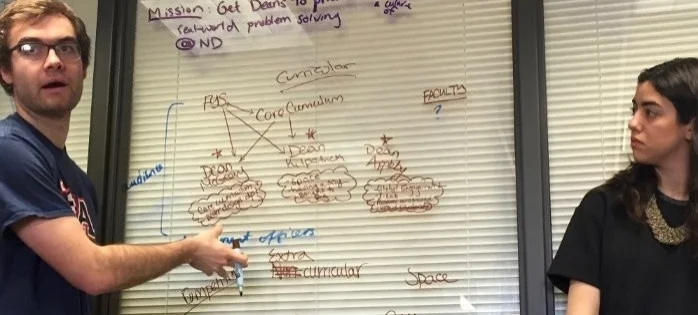Statistics tell us that 80% of Notre Dame students participate in some sort of service learning during their time at the university. In our class on “International Development and Design Thinking”, the number would be 100%. We could all relate to the topic of service learning, especially in an international context, and how service opportunities can be analyzed for their sustainability as well as their accountability to the communities they serve.
However, controversy arose when we tried to quantify the change being made by these service trips. We intentionally provoked students to think critically about service learning through readings and videos that challenged the idealization of international volunteering, suggesting that there are scenarios in which more harm is being done than good. For instance, imagine a scenario in which volunteers distribute vitamins to malnourished children.
At first glance, this seems to be a good, even a great, thing. However, follow-up with these communities may reveal that children ate all of the vitamins in one sitting and became constipated because of lack of instruction. Or, parents will choose to purchase vitamins in the future instead of other medications, which could have been more beneficial. The hidden “side effects” of these service trips are very rarely discussed, so we took this opportunity to ask students to consider their own experiences. Drawing on their own reflections, we then asked students how different aspects of their own service experiences could fit into three general models in the form of a stop sign:
Red: service made them stop and think if what they were doing was “right”
Yellow: service may have been sustainable, but unclear/ don’t know
Green: service brought long term change
We inspired conversations about how service can be beneficial, and what to beware of in the future when doing service. However, our imperfect analogy of the stoplight forced restrictions onto a topic that is by no means black and white. The blurred lines that exist between the red, yellow, and green muddled our ability to reduce projects to be totally good or totally bad. For instance, a classmate noted that while she had experience working with organizations that served vulnerable children, it was difficult to pinpoint what exact aspects of these organizations made some better than others.
It is important to consider different components of the same project individually, and to analyze them separately in terms of impact. Additionally, the sustainability of a project is difficult to define. If you have created a meaningful relationship with one person while there, does that count as having a sustainable impact, even if it is only one person? How many people do you need to impact to “make a difference”? Additionally, what is even considered short-term for service trips? A week? A month? A year?
I believe that my biggest take-away from planning and executing this class is the importance of considering the assumptions and the restrictions of certain topics. For instance, when we introduced the activity, we assumed that the class knew what we meant by a “green” scenario, when in reality we had not even begun to discuss the parameters of sustainable change. Additionally, we learned that certain aspects of service could not be restricted to just a red, yellow, or green, but that there existed a sliding scale of impact in which service can create both positive and negative change at the same time.
With this in mind, if we were to continue our conversation from class, I would begin by first discussing what we considered sustainable change and how to determine if service has a positive impact. Then, I would tweak our stoplight model to reflect the blurred lines and eliminate binds to “good” and “bad” labels. From here, I would hope to be able to develop our own ideas about what aspects of service lead to sustainable change. This would generate a mindset for our classmates when entering a service learning project that is conscious of the impact of their work.
If students are more mindful and critical of service, then contributions to sustainable change are possible e through the service learning model.



